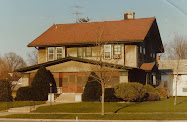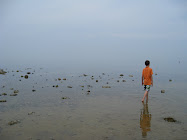
But my legs are short and my husband’s are long; I am always falling behind. And while I like the momentum and I like to keep moving, he often stops to look at things. He has incredibly acute powers of hearing and sight – he sees the birds and knows their calls, he zeroes in on the slightest movement, his peripheral vision is incredible. I see landscapes and colors and shapes, swaths of color and movement and shape; he sees birds and bugs and butterflies.
When we had children and began taking them on our walks, he would lead the way with the baby in the backpack and was our family grew I became somewhat resigned to bringing up the rear. Part of it was that I simply could not keep up, either from pregnancy or fatigue or simply needing to see everyone to keep us all together. I have dozens of photographs of the backs of my family as we traversed one beautiful spot after another. There were many moments when I did not like the view because watching them, even as I loved them, did not allow me the freedom to escape into the landscape, to be the leader and adventurer, to set the pace.
But somewhere along the line things began to change. As the children needed less carrying and cajoling I could steal moments to take in the views on either side of me; I realized it was not so important to look straight ahead.
There are a few walks we take every year, and one of them is to the top of Indian Hill, which has a distant view of the Berkshires. It was one of the first walks we ever took in our town, and I have a photograph of my husband with our oldest child, relaxing contentedly in the back pack wearing red sneakers and a smile, and my husband, tanned with tousled hair in looking joyously at the September sun.
Over the last dozen years, the walks up this steep hill became benchmarks, taking stock of how well I fit into my role at the back of the pack. There were years when we fairly sprinted up the root strewn path, plopping ourselves down in the mowed meadow at the top for a picnic and some foraging for apples in the languishing orchard that rambles down the other side. When allergies made eating the apples off limits, my husband, ever curious and resourceful, noticed the milkweed plants ripening on the other side of the meadow and each September trip became a family mission to pop open the pods and liberate the seeds in to the blue, blue autumn sky.
Sometime the journey was painful, with one child or another intransigent, demanding to be carried, stalking back down the hill in rebellion, or sitting down and refusing to move. On those days I wondered why we bothered, what kinds of memories we were creating, feeling the need to sit on my own form of protest. We would set out from home on a self-proclaimed death march, three crabbily recalcitrant children in tow. For my husband, who is bound to office and computer all week, such walks are necessary to his sanity, a tonic for his brain, as essential to him as eating and sleeping, and he needs our company to make the experience complete, and often we do not live up to the expectation of family harmony. We allow him to work all week for us, and then we begrudge him his playtime; selfish, petulant children, including me. And so we walk, and once we get moving, we are always glad we did.
Our most recent walk up Indian Hill was different. Our elder son and daughter took the lead. We went in October, and so some of the fields that are usually tall with grass had been mowed. The paths were no quite so clear and so the kids took a few wrong turns. When my husband followed them I stayed behind to take photographs, and I did not worry that they would get lost or that I would be left behind. I knew they would be back. I knew my way, and I was confident that they knew theirs.
When we reached the top, the milkweed had been mowed under. We had nothing to do after we had our picnic, but my husband and our youngest, determined to find adventure, disappeared into unmowed orchard and emerged triumphant, their arms loaded with milkweed pods. The unfettered joy with which they flung the seeds into the air is an image I will never forget. As my husband’s fingers twiddled the loosened the seeds into the air, the downy seeds caught the breeze and transported them up the hill, where our son danced beneath them, caught them and set them free again.
We took a different path down the hill through the orchard, liberating milkweed seeds all the way, taking in the smells of the drying grass and the overripe apples, looking at crazy quilt of colors stitched by the autumn trees. As the landscape flattened out, the tall stalks gave way to a carpet of thick green grass punctuated by thistle. We stopped to marvel at the confetti of butterflies, large and small, doing their dance in the October sun. It was as though we had wandered into some secret confluence of the seasons, where every phase of nature puts on a performance. Butterflies for spring, grass for summer, summer heat and the milkweed dressed up as snow. We had arrived somewhere, it seemed after years and miles of walking, a place uniquely good and whole and complete. A moment in which each of us occupied a space that was neither front not back nor in between, but together, like a complete year of seasons.
Now that our walks in the woods, forests and beaches are longer and more diffuse I use my position at the back of the pack to walk with one child or another to talk, to try and see what they see, and sometimes to observe that the best walks are often the ones we are most reluctant to take.



No comments:
Post a Comment